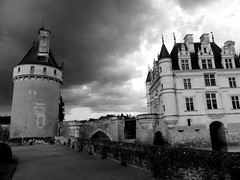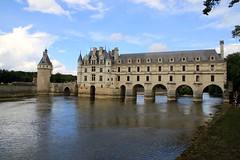Chenonceau, the Ladies’ chateau, has an interesting history as royal residence in the Loire and center of power in the 16th-century Kingdom of France.
Romantic Château de Chenonceau celebrated its official 500th anniversary at the start of 2013. When construction of the present Renaissance palace started in 1513, few could have expected that in the following century it would become a royal residence and home to such luminaries as Diane de Poitiers and Catherine de Medici. During the late-16th century, Chenonceau was at the center of political power in France. Like other Loire chateaux, Chenonceau fell into disuse and insignificance from the seventeenth century onwards. Chenonceau – often referred to as the Ladies’ Chateau due to the substantial influence women had on its development – is the second most-visited chateau in France and arguably the most romantic.
Medieval Chenonceau Castle
Traces of pre-historic settlements have been found at Chenonceau but the oldest written references go back to an 11th-century mill. A later fortress was destroyed in 1412, as punishment for an act of sedition, but the Marques family was allowed to rebuild the castle.
Of this medieval castle, only the keep was kept when Thomas Bohier built a chateau between 1513 and 1521. This makes Chenonceau one of the older Loire palaces and one of the earliest Renaissance buildings in France.
Château de Chenonceau came into royal hands in 1535 when King Francis I of France seized it in lieu of unpaid debts after the death of Thomas Bohier. Inscriptions above the door of the Marques tower and the salamander on the fireplace in the drawing room remind of Francis and Queen Claude.
Diane de Poitiers – A Royal Mistress at Chateau de Chenonceau
Live at Chenonceau got more interesting from 1547 onwards when King Henri II offered the chateau as residence to his mistress Diane de Poitiers (1499-1566). She loved the place and by 1555 was the legal owner of Château de Chenonceau.
Diane de Poitiers added a formal garden but more significantly had an arcaded bridge built from the palace to the opposite bank of the River Cher. She could not complete a gallery planned for the bridge.
The problem of being a royal mistress is that the affair may end or that the king may die first. In 1559, Henry II died and his widow – the formidable Catherine de Medici – bullied Diane into exchanging Chenonceau for the Château Chaumont.
Catherine de Medici Ruling from at Chateau de Chenonceau
Upon Henry II’s death, Catherine de Medici (1519-89), who the king kept out of government business and openly ignored in favor of the company of the much older Diane de Poitiers, suddenly found herself regent of France – a position she would find herself in for three of her sons, who were the last Valois kings of France.
Catherine loved Chenonceau and ruled (or at least tried to) France from the Green Study in the chateau. She completed the gallery on the bridge across the Cher but the planned second chateau on the opposite end of the river was never built.
Château de Chenonceau became the venue for lavish parties where Catherine could entertain and spy on the French nobility. The first firework display in France was held here in 1560 to commemorate the coronation of Francis II – crowned aged 15.
Decline of Château de Chenonceau
Catherine left Château de Chenonceau to her daughter-in-law Louise de Lorraine-Vaudémont. She spent her final years here in mourning for her husband King Henry III, who was assassinated in 1589, less than a year after the death of his mother.
Financial difficulties forced Louise to move out of Chenonceau a few years before her own death in 1601. The new mistress of the castle was also the mistress of King Henri IV – Gabrielle d’Estrées, although the ownership would go to her son César de Vendôme.
However, by the seventeenth century the center of power in France has shifted away from the Loire and Chenonceau was increasingly abandoned by politically influential owners. Many of the art and valuable furnishing were sold off – statues from Catherine de Medici’s gallery ended up in Versailles.
The Revival of Château de Chenonceau
Chenonceau experienced a Renaissance during the Enlightenment. Louise Dupin (1706-1799) entertained amongst others Montesquieu, Voltaire and Rousseau at Château de Chenonceau. She saved the castle from destruction during the French Revolution, in part by being popular with the locals but also as Chenonceau offered the only bridge across the River Cher. During the French Revolution, Chateau de Chenonceau lost the “x” that the adjacent village Chenonceaux still uses.
During the 19th century, Marguerite Pelouze from a rich industrial family restored much of the castle and transformed it to resemble the appearance during the times of Diane de Poitiers and Catherine de Medici.
Château de Chenonceau in the World Wars and Twentieth Century
Since 1913, Château de Chenonceau has been the property of the Menier family, who made their money from Menier chocolates (now owned by Nestlé). Once again a woman, Simone Menier (1881-1972), steered the direction of Château de Chenonceau.
During the First World War, she turned the gallery into a hospital for wounded soldiers. During the Second World War, from 1940 to 42, the palace was in the German-occupied part of France while the south end of the gallery was in Free or Vichy-France. The chateau could thus be used to cross between the two zones.
Although Simone played a role in the French Resistance, historians question whether Chenonceau could have been much of a useful transportation link. A German army group was on permanent standby to destroy the palace if necessary making crossings elsewhere certainly safer.
Today Château de Chenonceau is in a beautifully restored condition. The interior has some period furniture with walls and ceiling lavishly decorated and hung with old masters’ paintings and historic tapestries. The gardens of Diane de Poitiers and Catherine de Medici are maintained while a maze and further historic buildings are open to visitors. However, the gallery masterfully spanning the River Cher is still the main draw of romantic Château de Chenonceau.
For More on Château de Chenonceau See Also:
- Visiting Château de Chenonceau
- History of Chateau de Chenonceau
- Touring Chateau de Chenonceau
- Opening Hours and Tips on the Best Times to Visit Chateau de Chenonceau
- Visitors Information: Tickets and Opening Hours
- Transportation to Chateau de Chenonceau
- Photos of Chenonceau on Flickr
- Book Tours and Excursions to Chenonceau




